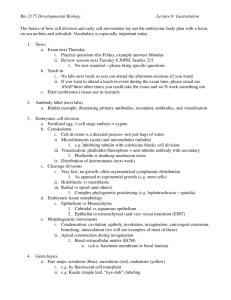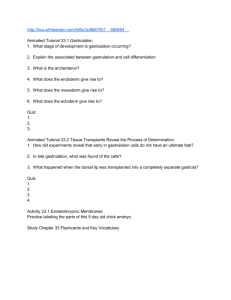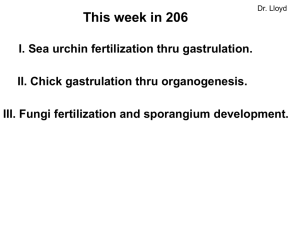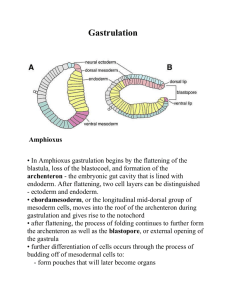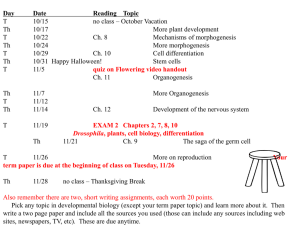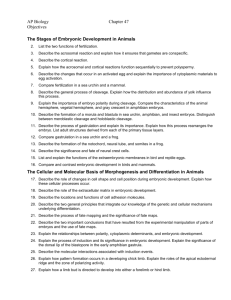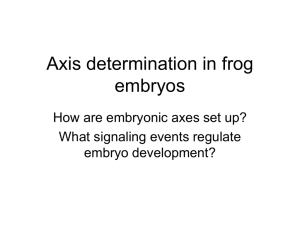mcclay_et _al_cell_i..
advertisement
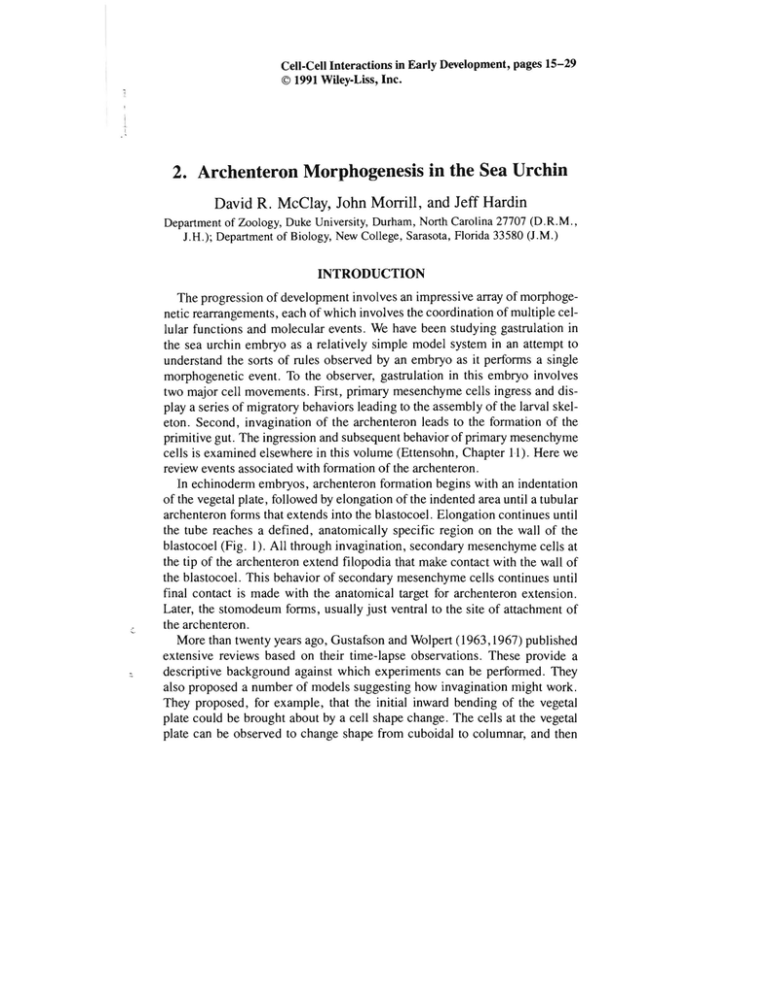
Cell-Cell Interactions in Early Development, pages 15-29
© 1991 Wiley-Liss, Inc.
I
.f
2. Archenteron Morphogenesis in the Sea Urchin
David R. McClay, John Morrill, and Jeff Hardin Department of Zoology, Duke University, Durham, North Carolina 27707 (D .R.M., J.H.); Department of Biology, New College, Sarasota, Florida 33580 (J .M.) INTRODUCTION
The progression of development involves an impressive array of morphoge­
netic rearrangements, each of which involves the coordination of multiple cel­
lular functions and molecular events. We have been studying gastrulation in
the sea urchin embryo as a relatively simple model system in an attempt to
understand the sorts of rules observed by an embryo as it performs a single
morphogenetic event. To the observer, gastrulation in this embryo involves
two major cell movements. First, primary mesenchyme cells ingress and dis­
playa series of migratory behaviors leading to the assembly of the larval skel­
eton. Second, invagination of the archenteron leads to the formation of the
primitive gut. The ingression and subsequent behavior of primary mesenchyme
cells is examined elsewhere in this volume (Ettensohn, Chapter 11). Here we
review events associated with formation of the archenteron .
In echinoderm embryos, archenteron formation begins with an indentation
of the vegetal plate, followed by elongation of the indented area until a tubular
archenteron forms that extends into the blastocoel . Elongation continues until
the tube reaches a defined, anatomically specific region on the wall of the
blastocoel (Fig . I). All through invagination, secondary mesenchyme cells at
the tip of the archenteron extend filopodia that make contact with the wall of
the blastocoel. This behavior of secondary mesenchyme cells continues until
final contact is made with the anatomical target for archenteron extension .
Later, the stomodeum forms, usually just ventral to the site of attachment of
the archenteron.
More than twenty years ago , Gustafson and Wolpert (1963,1967) published
extensive reviews based on their time-lapse observations . These provide a
descriptive background against which experiments can be performed. They
also proposed a number of models suggesting how invagination might work.
They proposed, for example, that the initial inward bending of the vegetal
plate could be brought about by a cell shape change . The cells at the vegetal
plate can be observed to change shape from cuboidal to columnar, and then
16
McClay et al.
Fig . I. Archenteron invagination in the sea urchin embryo. Cells of the endodenn rearrange
as the archenteron extends from the vegetal plate toward the animal pole region . (a) In a micro­
graph using Nomarski optics, numerous filopodia can be seen to be extending from secondary
mesenchyme cells at the tip of the archenteron before it reaches its target near the animal pole.
(b) A scanning electron micrograph of an embryo at a similar stage to that shown in a. Numerous
extracellular matrix fibers can be seen around the archenteron and lining the blastocoel wall.
some cells become keystone-shaped in profile (Fig. 2). Coincident with these
shape changes, the vegetal plate begins to bend inward . Mechanistically, the
shape change could be driven intrinsically by the cells of the vegetal plate, or
there could be external forces imposing the cell shape changes . One intrinsic
mechanism that has been proposed is apical constriction of cells (Rhumbler,
1902). Gustafson and Wolpert (J 963,1967) pointed out that changes in adhe­
sion of cells in the vegetal plate could be the mechanism leading to the apical
constriction; if cells lost adhesive affinity for the hyaline layer and gained affin­
ity for the lateral surfaces of neighboring cells, the keystone shape might result.
Alternatively, apical constriction was hypothesized to result from contraction
of circumapical microfilament bundles during amphibian neurulation by Burn­
side (1971) and Baker and Schroeder (1967; see reviews by Ettensohn, 1985b;
Fristrom, 1988 for further discussion). Later, stretch-activated constriction of
apical microfilaments was presented as a model for the initial invagination of
the archenteron in the sea urchin by Odell et al. (1981) . The major require­
ment for these models is that the cell shape changes should be driven locally.
Moore and Burt (1939) and later Ettensohn (1984) showed that isolated vege­
tal plates would invaginate on their own . This meant that global forces from
the remaining embryo, or from sort of negative pressure within the blasto­
coel, were not crucial for invagination. In addition , the vital staining experi­
ments of H6rstadius (1935) showed that there is no large global epibolous
Archenteron Morphogenesis in Sea Urchin
17
movement of cells toward the vegetal plate as it bends inward . When the veg2
layer of cells was stained, it was found that only the veg2 layer contributed to
the vegetal plate, and cells lateral to the inbending region do not move sub­
stantially toward it. These marking experiments were later refined by Ettensohn
(1984) to show that while there is some movement of marked regions of the
vegetal plate during the early phase of invagination, only the vegetal plate
contributes to the archenteron . Furthermore, dye marking and time-lapse
videomicroscopy indicate that there is no involution during the subsequent elon­
gation of the archenteron (Hardin, 1989) . Thus, the forces of invagination are
located near the vegetal plate and only cells of the vegetal plate contribute to
the archenteron. Does this indicate that the forces for invagination are gener­
ated within each cell? Perhaps, although there has been no formal test of that
hypothesis. Furthermore, it is not known what those forces might be. Are
they cytoskeletal changes? Or, as suggested by Gustafson and Wolpert, are
there changes in cell adhesion? Beyond these unanswered questions about the
mechanism of invagination itself, there is no understanding of the controlling
influences that help to initiate the invagination . Invagination begins after the
primary mesenchyme cells (PMCs) have ingressed in most species, though
removal of the PMCs from the blastocoel has no effect on the beginning of
the invagination movements (Ettensohn and McClay, 1988) . Thus, while the
descriptive information on the beginning phases of invagination is fairly com­
plete, there are many local forces that are incompletely understood . Below, we
discuss experiments that indicate a role for the synthesis of new embryonic
proteins during gastrulation. This de novo synthesis shows that there is devel­
opmentally regulated, differential gene expression concurrent with gastrula­
tion; however, the molecular regulatory apparatus that actually controls initiation
of the inbending at the vegetal pole is completely unknown .
THE SIGNAL TO INVAGINATE
At the molecular level, recent studies have suggested that there are spatial
and temporal regulatory molecules that activate genes at gastrulation (reviewed
by Davidson, 1988, 1989, 1990). Presumably, DNA binding proteins and induc­
tive signals are coordinated to activate the genes required for initiation of gas­
trulation. What are the signals and what genes are activated to initiate the
process of invagination? One idea is that there is some kind of internal clock
that directs presumptive endoderm cells at a certain time to begin their cell
shape change (Spiegel and Spiegel , 1986). Such a clock might rely entirely
upon cis regulatory elements that control entry into gastrulation as a result of
certain rate constants intrinsic to the cells. In indirect support of such a model
are the above experiments, in which only the presumptive vegetal plate region
need be present for invagination to begin, implying localized signals. Other
experiments, however, indicate that the timing model is probably incorrect
18
McClay et a1.
Fig . 2. (a) A scanning electron micrograph showing an embryo that has been split along a
midsagittal plane. At the vegetal plate the early stages of invagination show a number of pre­
sumptive endoderm cells that have changed shape either causing or in response to the forces that
initiate the invagination. (b) An embryo that has been cut lateral to the midsagittal plane to
show the bulge in the vegetal plate and the primary mesenchyme cells surrounding the indenta­
tion and lining the blastocoel wall.
and that epigenetic signals are necessary to launch the invagination program.
If one disrupts the interaction of cells with the hyaline layer (Adelson and
Humphreys , 1988), or with the basal lamina (Wessel and McClay, 1987; But­
ler et aI., 1987) , gastrulation is totally blocked. In both cases, the blockage is
not permanent since the effects are reversible. Once the block is removed,
gastrulation begins and normal larvae result. These data indicate that timing
cannot be an explanation since the embryos can be held at the mesenchyme
blastula stage for extended periods of time and then allowed to continue with
normal development. Instead, the data suggest that the embryos are respon­
sive to epigenetic signals for continuation of development.
What is the block to gastrulation and what does it tell us about the putative
epigenetic signals that appear to be necessary for gastrulation? Presumptive
endoderm cells adhere to at least two hyaline layer proteins, hyalin (McClay
and Fink, 1982; Fink and McClay, 1985) and echinonectin (Alliegro et aI.,
Archenteron Morphogenesis in Sea Urchin
19
1988; Burdsal et al., 1991). A monoclonal antibody to hyalin was produced
that blocked the interaction of cells to hyalin substrates (Adelson and Hum­
phreys, 1988). When the antibody was added to embryos at low concentra­
tions (5-10 f.Lg/ml), invagination movements failed to occur. Blastomeres pulled
away from the hyalin layer and the embryos appeared to shrink. By a number
of criteria, the cells continued to metabolize and many genes continued to be
expressed at the pregastrula levels (Adelson and Humphreys, 1988). The inhibi­
tory effect could be reversed if the antibody were washed out of the culture
medium.
While inhibition of gastrulation by blocking cell adhesion to hyalin was dra­
matic, a second kind of inhibition suggests the epigenetic signal is not specific
to the cell-hyalin interaction. Treatment of embryos with J3-aminoproprio­
nitrile (J3APN) also inhibits gastrulation (Wessel and McClay, 1987; Butler et
al., 1987). This lathrytic agent inhibits lysyl oxidase, the enzyme required for
cross-linking of collagen. It was found that embryos would grow to the mes­
enchyme blastula stage in the presence of the J3APN, but no further. If left in
the drug, the embryos remained at the mesenchyme blastula stage (Fig . 3),
and continued to express all genes measured, including collagen, at control
mesenchyme blastula levels . If the embryos were removed from the drug, they
resumed development to nonnal pluteus larvae. New transcription of endoder­
mal genes failed to occur until the drug was removed. Of importance, embryos
could be held in the arrested state for long periods of time (Fig. 3), yet when
released they progressed through development nonnally from that point onward.
The J3APN treatment was shown to block the cross-linking of collagen, and
other basal laminar proteins also failed to beassembled into the basal lamina
during the treatment. These data indicate that an intact basal lamina is some­
how important for initiation of gastrulation. From other studies it was known
that cells of the mesenchyme blastula adhere to the basal lamina (Fink and
McClay, 1985; Katow and Solursh, 1981; Solursh, 1986), but it is not known
whether the lack of adhesion directly, or some other signal indirectly depen­
dent upon adhesion, is the critical element missing from the blocked embryos.
An interaction with the basal lamina might be instructive, or, more likely,
simply pennissive for further development. Whatever the reason for the inhi­
bition of gastrulation by J3APN, or for that matter with other inhibitors such
as xylosides (Solursh et al., 1986; Lane and Solursh, 1988), the reversibility
of the treatment indicates that a critical epigenetic event occurs at the begin­
ning of gastrulation. Proper assembly of the basal lamina or the hyalin layer can
be blocked at any stage of development up to gastrulation without any notice­
able effect. Data have indicated that the sensitivity to these reagents exists for
only about 2 hr. Addition of the reagents before the mesenchyme blastula stage
has no effect until mesenchyme blastula stage, or, if added after the brief period
of high sensitivity, the reagents have a reduced effect on further development
(Fig. 3).
20
McClay et al.
~
~
~
,1----0
ohr. 5 hr
10 hr.
18 hr.
24 hr.
48 hr.
Nonnal development
~APN
"--------(Q) ~. . . . .
(Q)-~
anti-hyalin
D ASW
~
Experimental treatment
Fig . 3. Diagram summarizing treatments with l3 -aminoproprionitrile (I3APN) and antibody
to hyalin . At the top , a time line shows several stages in development. The bars indicate embryos
that were incubated in the presence (hash marks) or absence (open bar) of I3APN or antihyalin .
When left in I3APN, the embryos reached the mesenchyme blastula stage on schedule but were
arrested . The arrested behavior could be reversed (second bar) if the embryos were later washed
in seawater without I3APN. The critical period of sensitivity was at the mesenchyme blastula
stage since embryos were arrested if I3APN was added at the mesenchyme blastula stage (third
bar), or they developed normally and on schedule if released from I3APN at the mesenchyme
blastula stage. Similar results were seen with antihyalin .
A number of marker proteins have been identified that are expressed in the
endoderm at the beginning of gastrulation (McClay et aI., 1983; Wessel and
McClay, 1985; Wessel et al., 1989a; Nocente-McGrath et aI., 1989) . All appear
to be dependent for their expression on the f3APN-sensitive event. Among
the genes expressed, presumably, are the genes required for the initiation of
the invagination of the vegetal plate. Although the critical genes are not known,
several properties of the invaginating tissue must be accounted for in the sequence
of events that follow. First , the cells have apical-basal polarity (Schroeder,
Archenteron Morphogenesis in Sea Urchin
21
1988; Nelson and McClay, 1988), and secrete matrix components toward both
surfaces. The signal that launches the inward folding, if present inside each of
the cells that change shape, must be responsive to that polarity. Second, as
described below, the cells begin to rearrange within the plane of the cell sheet.
This requires the onset of cell motility to drive the cell neighbor changes, and
could require synthesis of new cell adhesion molecules . Third, directionality
must somehow be present. The cells move in a net inward direction and so
there must be some kind of signal imparted to the cell sheet that gives it that
directionality. Finally, the movements must somehow be coordinated . Clearly,
all of these processes are launched early in gastrulation, but the molecular
identity of the components involved still are not known in any system.
DEEPENING THE INVAGINATION
The archenteron begins to elongate following the initial inward bending of
the vegetal plate. The first half to two-thirds of the invagination are brought about
largely by cell rearrangements described as "convergence and extension" in
other morphogenetic systems (Fristrom, 1988; Keller, 1987) (Fig. 4a). Sev­
eral kinds of experiments ~emonstrate that convergence-extension is a major
mechanism of archenteron elongation . First, by counting cells in cross sec­
tions of the tube, it was observed that the number of cells in any given cir­
cumference steadily declined (Ettensohn, 1985a; Hardin and Cheng, 1986).
Second, dye marking experiments showed that the elongation is local, i.e.,
there is no recruitment of cells from areas lateral to the site of invagination
(Hardin, 1989) . The only way to explain these observations is a rearrange­
ment of the cells. Third, a patch of presumptive endoderm was marked with a
fluorescent tag and observed throughout gastrulation. Cells in the patch shifted
position relative to one another during gastrulation, resulting in a highly elon­
gated patch of labeled cells (Fig. 4) (Hardin, 1989) . Fourth, time-lapse films
of the archenteron have detected shifts in cell position along the axis of elon­
gation (Hardin, 1989). Finally, the one other major mechanism proposed for
primary elongation of the archenteron, as suggested by Gustafson and Wolpert,
was a pulling force due to traction of the secondary mesenchyme cells. The
necessity for such traction is ruled out since exogastrulae extend archenterons
without benefit of secondary mesenchyme pulling, and laser ablation experi­
ments destroyed filopodia but the archenteron continued to extend until it reached
up to two-thirds its final length (Hardin, 1988).
Cell adhesion changes also occur during the time of invagination as dem­
onstrated by aggregation and sorting experiments (McClay et al., 1977; Bernacki
and McClay, 1989) . These changes readily show that endoderm cells develop
the capacity to recognize one another relative to ectoderm and mesoderm. How­
ever, it is not known whether these experimentally observed adhesive changes
might actually be important for the invagination process. The germ layers really
22
McClay et at.
/
o
Archenteron Morphogenesis in Sea Urchin
23
do not sort out from one another during normal invagination since the cells
already are physically isolated from one another. The adhesion changes may
reflect newly acquired properties that contribute to endodermal cell-cell rear­
rangements. In cell aggregates, endodermal cells quickly rearrange to form a
tubular structure, demonstrating their tendency to interact with one another
and to form a cell sheet one cell deep (Spiegel and Spiegel, 1975; Bernacki
and McClay, 1989).
The most elusive property of gastrulation, and one of the most critical, is
the directionality of invagination. If one examines the basal end of the endo­
dermal ceUs during gastrulation, they can be seen to overlap adjacent cells in
the direction of net movement of the archenteron (Hardin, 1989) . How do the
cells know which way is which? Apparently information along the animal­
vegetal axis is all that is needed since the elongation continues when the
dorsal-ventral axis has been destroyed (Hardin et aI., in preparation). The
signal probably is local (as opposed to global) since the archenteron continues
to elongate in embryos that have had the animal hemisphere removed. This
point of reference in space is an important element of all pattern-forming sys­
tems. Many experiments in the sea urchin embryo point to the existence of
such directional signals; however, in this and in other embryonic systems, the
identity of such signals remains obscure.
SECONDARY MESENCHYME CELL BEHAVIOR DURING ARCHENTERON FORMATION Films of gastrulation show the dramatic sequence of filopodial extension
and retraction exhibited by secondary mesenchyme cells (Fig. 5). Although it
was shown experimentally that filopodial activity is not required for the first
two-thirds of the extension of the archenteron (Hardin, 1988), completion of
extension requires filopodia (Hardin, 1988, 1989). Indeed, toward the end of
the extension process when filopodia finally reach the point at which the arch­
enteron attaches to the wall of the blastocoel, one can observe a transient cell
shape change in endodermal cells suggestive of a stretching in the direction of
archenteron movement (Hardin, 1989). As indicated above, even though the
filopodia are extended all through gastrulation, they apparently are not crucial
until the last phases of the extension.
Fig. 4. Rearrangement of endoderm during archenteron elongation. (a) Diagrams of the cross
section of the archenteron at an early and of a later stage of invagination. Many more cells line
the lumen early in invagination compared with later. This observation enabled Ettensohn (1985a)
to deduce that endoderm cells rearrange during invagination. (b,c) Phase micrographs of (d)
and (e). A patch of presumptive endoderm was tagged with rhodamine isothiocyanate. Early in
gastrulation (b,d) the patch was rounded and at the vegetal plate. Late in gastrulation (c,e) the
patch had rearranged so that cells were found in a long thin linear array (Hardin, 1989), provid­
ing evidence for the cell rearrangement that occurs during invagination .
24
McClay et al.
Fig. 5. Secondary mesenchyme cells extend filopodia for the duration of invagination. (a) A
Ly/echinus pic/us mi{!gastrula stage showing numerous filopodia. (b) A late gastrula embryo
showing the secondary mesenchyme cells reaching the target , and one long filopodium at the
left. (c) A scanning electron micrograph showing the extension of three filopodia (arrows) from
the archenteron (at left) to the blastocoelic wall (at right). The tips of the filopodia are enmeshed
in extracellular matrix fibers.
~
Archenteron Morphogenesis in Sea Urchin
25
~. ~
du - ~
~- m
(fnl) _1M
YU =-ru:::.
indent
animal pole
I
00-
nonnal
attachment
~=. ~- at) .=:,
~~"
I
,
.
.
attachment of
single cells
,
'
Fig. 6. Summary diagram of experiments demonstrating the existence of a target for archen­
teron extension (Hardin and McClay, 1990) . If embryos are indented at the animal pole , there is
a premature attachment to the target region. If the indentation is made laterally, the archenterons
make contact but continue to move until the target region is reached . If the embryos are experi­
mentally elongated, the archenteron fails to reach the target region , filopodia! extension contin­
ues, and this behavior continues until embryos are released, allowing the archenteron to attach
to its target region. Only when the target is reached do the secondary mesenchyme cells change
their behavior by ending the repetitive extension of filopodia and assuming a flattened phenotype.
A curious characteristic of secondary mesenchyme cells was that many filo­
podia were extended without making contact with a substrate (Fig. 6) (Hardin
and McClay, 1990). A careful study of filopodial behavior revealed that when
contact was made with the wall of the blastocoel, the cells held that contact
for intervals lasting from 2 to 10 min. If cells did not reach a substrate within
about 35 J.Lm, the filopodia were withdrawn. This behavior continued for the
duration of gastrulation, until contact was made with a region of the blasto­
coel wall near the animal pole. When contact with this region was made, the
behavior of secondary mesenchyme cells changed dramatically. The duration
of contact was extended much beyond the 10 min maximum that was observed
up until then, and in many cases the filopodia were never withdrawn from the
animal pole region. In addition, the secondary mesenchyme cells changed phe­
notype and took on a more fibroblastic appearance.
Was there something special about contact with the animal pole region of
the embryo that led to the behavior change? Or was the change in the second­
ary mesenchyme cells independent of a contact-mediated stimulus that might
26
McClay et al.
exist in the animal pole region? The experiments that follow show that con­
tact with a specific target region is necessary for the phenotypic change to
occur. Comparative studies in other species, described below, also indicate
that for each species there is an anatomical target for attachment of the arch­
enteron. The experiments that reveal the existence of the target and some of
the properties of that target are described below.
A TARGET FOR ARCHENTERON EXTENSION
Since the filopodial behavior, described above, continues for the duration
of gastrulation until contact with the blastocoelic wall is made, the question
arises as to whether the change in secondary mesenchyme cell phenotype could
be induced precociously by early contact with the animal pole region. By sim­
ply pushing the animal pole region into contact with the archenteron tip, the
secondary mesenchyme cells changed phenotype much earlier in response (rel­
ative to control embryos of the same age). If contact with the animal pole
region were prevented by preventing the secondary mesenchyme cells from
reaching the animal pole region, one might predict (if contact were essential)
that secondary mesenchyme cells would continue their filopodial extension
behavior for an abnormally prolonged time. This prediction was tested by insert­
ing embryos into narrow-bore glass tubes so that the embryos were elongated
(Fig. 6). It was observed that filopodial extension continued for hours longer
than the behavior occurred in the control embryos. If the embryos were released
from the tubes, they rounded up, contact with the animal pole region was
made, and the phenotypic change occurred. Thus, until contact with the ani­
mal pole was made, the secondary mesenchyme cells continued their filopodial
extension behavior (Hardin and McClay, 1990).
The contact-induced change in phenotype occurred when the secondary mes­
enchyme cells reached the animal pole. Was that the only region of the
blastocoelic wall capable of inducing the phenotypic change? To address this
question, the tip of the archenteron was brought into contact with other regions
of the blastocoelic wall by denting the wall from the side (Fig. 6). Although
extensive filopodial contact was made with these indentations, the filopodial
contact was brief (in the 2-10 min range), and the archenterons continued to
extend until contact with the animal pole was made. Thus, only contact with
the animal pole region brought about the phenotypic change.
Secondary mesoderm cells give rise to pigment cells, cells of the coelomic
pouches, and muscle (Gibson and Burke, 1985). Normally these cells do not
participate in the production of the larval skeleton, although experiments
have shown that secondary mesenchyme cells retain the capacity to produce
spiCUles until quite late in gastrulation (Ettensohn and McClay, 1988; Etten­
sohn, 1990). This lineage conversion is a property of the secondary mesen­
chyme cells that can be induced experimentally by depriving the embryo of
Archenteron Morphogenesis in Sea Urchin
27
cells of the primary mesenchyme cell lineage from very early in development
(Horstadius, 1939), through gastrulation (Ettensohn and McClay, 1988), until
about the time of target contact (Ettensohn, 1990). In lineage mapping, stud­
ies have yet to determine when secondary mesenchyme cells are specified.
The experiments of Ettensohn (1990) suggest that the lineage is finally com­
mitted irreversibly sometime around the end of gastrulation, or at about the
time the secondary mesenchyme cells undergo the contact-mediated pheno­
typic change . The striking correlation between Ettensohn's experimental results
showing loss of lineage conversion capacity and the phenotypic change observed
in the present experiments suggest that at least one consequence of striking
the target at the animal pole might be commitment toward the restricted fate
of the secondary mesenchyme cell lineage.
The process of archenteron extension appears to have two critical control
steps, based upon the experiments described above. At the beginning of invag­
ination the cells are very sensitive to interactions with the extracellular matrix.
Expression of a number of genes that normally are transcribed coincident with
the beginning of invagination fails to occur unless, or until, contact with the
extracellular matrix is established. At the end of gastrulation, target contact
may be involved in cell lineage restriction of secondary mesenchyme cells
(although this notion is entirely correlative at present). As the archenteron
extends, cells appear to follow a simple set of instructions that may be given
once at the beginning of gastrulation. The endoderm cells rearrange, and the
secondary mesenchyme cells send out filopodia until further notice. The' 'further
notice" appears to be contact with the target region. The accuracy of this model
remains to be tested rigorously. Nevertheless, the behavioral data gathered,
the inhibitor studies, the lineage conversion studies, and the gene expression
studies that have been performed during gastrulation all support this idea.
What is meant by the phrase "set of instructions," as used above? Taking
the behavior of the endodermal cells as an example, it is clear that the cells per­
form many behavioral subroutines, each of which must be coordinately regulated
at the molecular level with the others. Indeed, at the beginning of gastrulation
it is known that a group of genes is transcribed coordinately in the endoderm
(McClay et aI., 1983; Wessel et aI., 1989a; Nocente-McGrath et al., 1989) (al­
though expression of those genes has not been linked directly to the behaviors
observed by the cells). Cells become motile and undergo circus movements that
appear to jostle the cells as viewed by time lapse. They rearrange in an ordered
sequence that involves initiating and breaking cell adhesions. They converge
and extend the archenteron directionally. All through elongation the cells retain
contact with the luminal matrix and the basal lamina. Each of these component
cell behaviors must have a molecular basis, and that group of molecules must
be under coordinate regulation . Thus, while it is easy to state that the behavior
is a simple programmed sequence, this incomplete list of functions indicates
that a complex network of molecular events underlies the process.
28
McClay et al.
REFERENCES
Adelson DL , Humphreys T (1988): Sea urchin morphogenesis and cell-hyalin adhesion are per­
turbed by a monoclonal antibody specific for hyalin. Development 104:391-402.
Alliegro MC, Euensohn CA, Burdsal CA , Erickson HP, McClay DR (1988): Echinonectin: A
new embryonic substrate adhesion protein. J Cell Bioi 107:2319-2327.
Baker PC, Schroeder TE (1967): Cytoplasmic filaments and morphogenetic movement in the
amphibian neural tube. Dev Bioi 15:432-450.
Bernacki SH, McClay DR (1989): Embryonic cellular organization: Differential restrictions of
fates as revealed by cell aggregates and lineage markers. J Exp Zool 251 :203-216.
Burdsal CA , Alliegro MC, McClay DR (1991): Tissue-specific temporal changes in cell adhesion
to echinonectin in the sea urcliin embryo . Dev Bioi 144:327-344.
Burnside B (1971): Microtubules and microfilaments in newt neurulation. Dev Bioi 26:416-441.
Butler E, Hardin J, Benson S (1987): The role of Iysyl oxidase and collagen crosslinking during
sea urchin development. Exp Cell Res 173: 174-182.
Davidson E (1988): "Gene Activity in Early Development," 3rd ed. New York: Academic Press .
Davidson EH (1989): Lineage-specific gene expression and the regulative capacities of the sea
urchin embryo: A proposed mechanism. Development 105:421-445.
Davidson EH (1990): How embryos work: A comparative view of diverse modes of cell fate
specification. Development 108:365-389.
Enensohn CA (1984) : Primary invagination of the vegetal plate during sea urchin gastrulation .
Am Zool 24:571-588.
Ettensohn CA (1985a): Gastrulation in the sea urchin is accompanied by the rearrangement of
invaginating epithelial cells. Dev Bioi 112:383-390.
Ettensohn CA (1985b): Mechanisms of epithelial invagination. Q Rev Bioi 60:289-307 .
Euensohn CA (1990): The regulation of primary mesenchyme cell pauerning . Dev Bioi
140:261-271.
Ettensohn CA, McClay DR (1988): Cell lineage conversion in the sea urchin embryo. Dev BioI
125:396-409.
Fink RD, McClay DR (1985): Three cell recognition changes accompany the ingression of sea
urchin primary mesenchyme cells. Dev BioI 107:66-74.
Fristrom 0 (1988) : The cellular basis of epithelial morphogenesis. A review. Tissue Cell
20:645-690.
Gibson AW, Burke RD (1985): The origin of pigment cells in embryos of the sea urchin
Strongywcentrotus purpurarus. Dev BioI 107:414-419.
Gustafson T, Wolpert L (1963): The cellular basis of morphogenesis and sea urchin develop­
ment. Int Rev Cyt 15: 139-214.
Gustafson T, Wolpert L (1967): Cellular movement and contact in sea urchin morphogenesis.
Bioi Rev 42:442-498.
Hardin J (1988): The role of secondary mesenchyme cells during sea urchin gastrulation studied
by laser ablation. Development 103:317-324.
Hardin J (1989): Local shifts in position and polarized motility drive cell rearrangement during
sea urchin gastrulation. Dev Bioi 136:430-445.
Hardin JD, Cheng LY (1986): The mechanisms and mechanics of archenteron elongation during
sea urchin gastrulation. Dev Bioi 115:490-50 I.
Hardin J , McClay DR (1990): Target recognition by the archenteron during sea urchin gastrula­
tion . Dev Bioi 142: in press .
Horstadius S (1935) : Uber die Determination im Verlaufe der Eiachse bei Seeigeln. Pubbl. Staz.
Zoo!. Napoli 14:251-429.
Horstadius S (1939): The mechanics of sea urchin development, studied by operative methods.
Bio Rev Cambridge Philos Soc 14:132-179.
~
Archenteron Morphogenesis in Sea Urchin
29
KalOw H , Solursh M (1981): Ultrastructural and time-lapse studies of primary mesenchyme cell
behavior in normal and sulfate-deprived sea urchin embryos. Exp Cell Res 136:233-245.
Keller RE (1987): Cell rearrangement in morphogenesis. Zool Sci 4:763-779 .
Lane MC, Solursh M (1988): Dependence of sea urchin primary cell migration on xyloside­
and sulfate-sensitive cell surface-associated components. Dev Bioi 127:78-87.
McClay DR , Fink RD (1982): Sea urchin hyalin: Appearance and function in development. Dev
Bioi 92:285-293 .
McClay DR, Cannon GW, Wessel GM, Fink RD, Marchase RB (1983) Patterns of antigenic
expression in early sea urchin development. In Jeffrey W, Raff R (eds): "Time, Space, and
Pauern in Embryonic Development." New York: Alan R. Liss, pp 157-169.
McClay DR , Chambers AF, Warren RG (1977): Specificity of cell-cell interactions in sea urchin
embryos. Appearance of new cell-surface determinants at gastrulation . Dev BioI56:343-355 .
Moore AR, Burt AS (1939): On the locus and nature of the forces causing gastrulation in the
embryos of Dendrasler excenrricus . J Exp Zool 82 : 159-171 .
Nelson SH , McClay DR (1988): Cell polarity in sea urchin embryos: Reorientation of cells
occurs quickly in aggregates. Dev Bioi 127:235-247.
Nocente-McGrath C , Brenner CA, Ernst SG (1989): Endo 16, a lineage-specific protein of the
sea urchin embryo, is first expressed just prior to gastrulation. Dev Bioi 136:264- 272.
Odell GM, Oster G , Alberch P, Burnside B (1981): The mechanical basis of morphogenesis.
I. Epithelial folding and invagination. Dev Bioi 85:446-462 .
Rhumbler L (1902): Zur Mechanik des Gastrulationsvorganges insbesondere der Invagination .
Arch Entwicklungsmech Org 14:401-476.
Schroeder TE (1988): Contact-independent polarization of the cell surface and cortex of free
sea urchin blastomeres. Dev Bioi 125:255- 264 .
Solursh M (1986): Migration of sea urchin primary mesenchyme cells. In Browder L (ed):
" Developmental Biology: A Comprehensive Synthesis: The Cellular Basis of Morphogene­
sis, Vol. 2" New York: Plenum Press, pp 391-431.
Solursh M, Lane MC (1988): Extracellular matrix n-iggers a directed cell migratory response in
sea urchin primary mesenchyme cells . Dev Bioi 130:397-401 .
Solursh M, Mitchell SL, Katow H (1986): Inhibition of cell migration in sea urchin embryos by
~-D-xyloside . Dev Bioi 118:325-332.
Spiegel M, Spiegel E (1975): The reaggregation of dissociated embryonic sea urchin cells. Am
ZooI15:583-606 .
Spiegel M, Spiegel E (1986): Cell-cell interactions during sea urchin morphogenesis. In Browder
L (ed): "Developmental Biology: A Comprehensive Synthesis." New York: Plenum Press,
pp 195-240.
Wessel GM, McClay DR (1985): Sequential expression of germ-layer specific molecules in the
sea urchin embryo. Dev Bioi 111:451-463 .
Wessel GM, McClay DR (1987): Gastrulation in the sea urchin embryo requires the deposition
of cross linked collagen within the extracellular matrix. Dev Bioi 121 : 149-165.
Wessel GM , Goldberg L, Lennarz: WJ, Klein WH (1989a): Gastrulation in the sea urchin embryo
is accompanied by the accumulation of an endoderm-specific mRNA. Dev Bioi 136:526-536.
Wessel GM, Zhang W. Tomlinson CR, Lennarz WJ , Klein WH (1989b): Transcription of the
Spec I-like gene of Lytechinus is selectively inhibited in response to disruption of the extra­
cellular matrix . Development 106:355-365.
